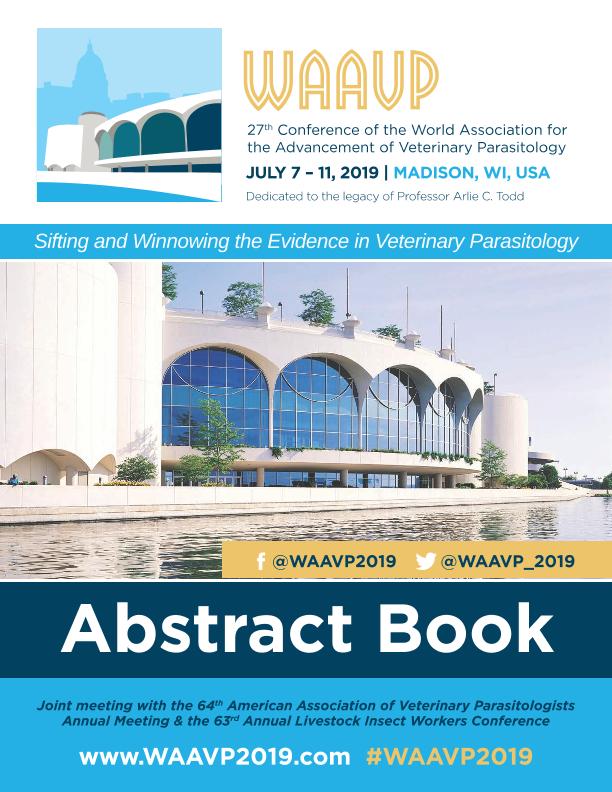Evento
Efficacy of different concentrations of duddingtonia flagrans chlamydospores against different levels of faecal egg counts of cattle gastrointestinal nematodes
Zegbi, Sara ; Sagüés, María Federica
; Sagüés, María Federica ; Saumell, Carlos Alfredo; Iglesias, Lucía Emilia; Guerrero, Ines; Fernández, Alicia Silvina
; Saumell, Carlos Alfredo; Iglesias, Lucía Emilia; Guerrero, Ines; Fernández, Alicia Silvina
 ; Sagüés, María Federica
; Sagüés, María Federica ; Saumell, Carlos Alfredo; Iglesias, Lucía Emilia; Guerrero, Ines; Fernández, Alicia Silvina
; Saumell, Carlos Alfredo; Iglesias, Lucía Emilia; Guerrero, Ines; Fernández, Alicia Silvina
Tipo del evento:
Conferencia
Nombre del evento:
27th Conference of the World Association for the Advancement of Veterinary Parasitology
Fecha del evento:
07/07/2019
Institución Organizadora:
World Association for the Advancement of Veterinary Parasitology;
Título del Libro:
Abstract Book: 27th Conference of the World Association for the Advancement of Veterinary Parasitology
Editorial:
World Association for the Advancement of Veterinary Parasitology (WAAVP)
Idioma:
Inglés
Clasificación temática:
Resumen
The nematophagous fungus Duddingtonia flagrans is a biocontrol agent that reduces the number of infective larvae of gastrointestinal nematodes in animal faeces, thus, lowering pasture infectivity. However, the minimum amount of fungal chlamydospores in faeces required for this effect is largely unknown. The following in vitro study aimed to determine the fungal efficacy of four different chlamydospores concentrations against three different levels of cattle faecal eggcounts. The chlamydospores concentrations tested were 11000, 6250, 3000 and 1000chl/g faeces. Faeces from naturally-infected calves were used to obtain faecal egg counts of 100, 480 and 840 epg. Ten faecal cultures of 10 g faeces each were set up for each chlamydospores concentration/faecal egg count combination, plus one control group for each faecal egg count level without chlamydospores. All cultures were kept at room temperature (20-26ºC) for two weeks and then L3 were recovered from each individual culture by overnight baermannisation, counted and identified. Thelarval reductions by D. flagrans, in decreasing order of chlamydospores concentrations, were: 100% (P<0.0001), 99% (P<0.0001),92% (P=0.0032) and 77% (ns) comparedto the 100 epg control; 100% (P<0.0001),98% (P<0.0001), 98% (P=0.0002) and 92%(ns) compared to the 480 epg control; and100% (P<0.0001), 100% (P<0.0001), 99%(P<0.0001) and 96% (ns) compared to the840 epg control. There were no differences between the three levels of faecal egg counts at any given fungal concentration, which indicates that the numbers of nematode eggsin cattle faeces would not be a determining factor for the efficacy of D. flagrans. These results suggest that the concentration of 1000 chl/g faeces would not be sufficient to achieve a significant fungal efficacy; however,it could be argued that, in practice, larval reductions of 77% to 96% would contribute tocontrol gastrointestinal nematodes.
Archivos asociados
Licencia
Identificadores
Colecciones
Eventos(CIVETAN)
Eventos de CENTRO DE INVESTIGACION VETERINARIA DE TANDIL
Eventos de CENTRO DE INVESTIGACION VETERINARIA DE TANDIL
Citación
Efficacy of different concentrations of duddingtonia flagrans chlamydospores against different levels of faecal egg counts of cattle gastrointestinal nematodes; 27th Conference of the World Association for the Advancement of Veterinary Parasitology; Madison; Estados Unidos; 2019; 257-257
Compartir



